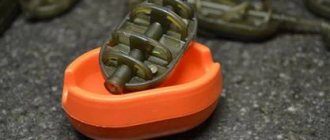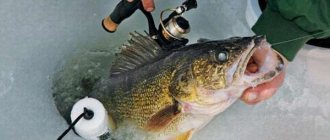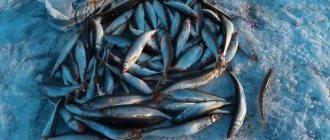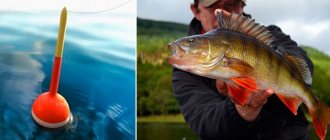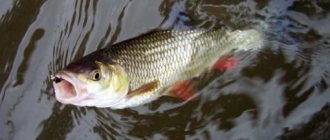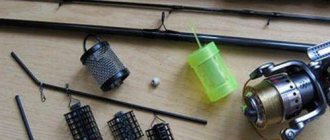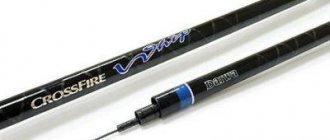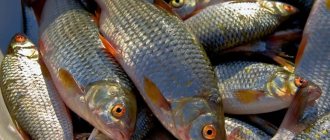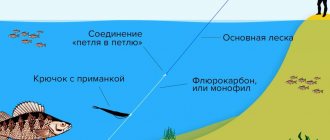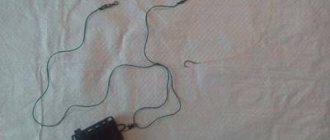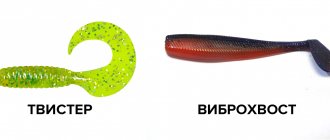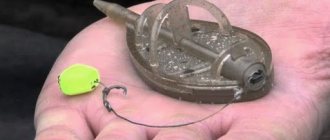For those who have never used this fishing method, fly rod may seem strange. An unnaturally short handle and a reel located below the handle can only cause bewilderment for a fisherman accustomed to traditional gear. That is why fly fishing is considered a separate method of fishing. And the fly fishing tackle is unique.
Fly fishing
Many fish (trout, taimen, grayling, chub and others) get their food from the surface of the reservoir or in the near-surface layer. Casting and keeping bait on the surface with traditional gear is quite a difficult task.
This bait is too light for ordinary tackle. Even a weak breeze easily blows it away at the moment of casting. Fish in the near-surface layer see well and at the same time stand against the current in the river. The bait has to be supplied in such a way that it is carried by the current to the fish sites, while the fisherman remains unnoticed. Difficult task. It is incredibly difficult to achieve this with ordinary tackle, even with a fair wind.
Therefore, the trendsetters of fishing fashion, the British, came up with a fishing method in which the bait is fed to the required distance not due to the weight of the bait, but due to the properties of the elastic cord used in the equipment instead of fishing line. The experience of the British was used by the Americans, who are currently leaders in this method of fishing and most of the new products associated with fly fishing appear in Europe from America.
This method of fishing is called fly fishing. It is widely used in fishing on cold, fast-moving rivers, usually with a rocky bottom and shallow depth. In addition, fly fishing has taken root in fishing (for the same trout) in lakes, mangrove forests, coral reefs, and in the tropical forests of Asia, Africa and America.
Of course, modern fly fishing as a fishing method is seriously different from the one with which the British began. Much has changed in fisherman's equipment since those times, but the basic elements have remained the same.
Fly fishing gear
Fly fishing is carried out with a rod specialized for the method, which, depending on its power, is divided into 12 classes. In fishing stores you can find on sale a ready-made set of tackle with all the elements necessary to provide a fishing technician. But there is also the opportunity to assemble your own fly fishing tackle. Talk about the fabulous price of this kind of kit is more fiction than reality. It is possible to assemble an effective fishing rod knowing the parameters and characteristics of the necessary components of the kit for adequate and not exorbitant money. It is about these elements that our conversation continues.
Rod
You can choose a fly fishing rod based on the trophy you plan to catch.
Important! As a rule, for beginning fly fishers, the optimal and universal option is class 6–7 gear.
Fishing rod blanks are made of fiberglass, carbon fiber and bamboo. Bamboo lightweight and highly balanced whips will have the highest price level. Like most modern classic fishing rods and spinning rods familiar to fishermen, the fly rod has parameters for test and structure. Fly fishing tests are quite small, akin to ultralight, and the fast and ultra-fast action allows you to most comfortably cast light lures and control them on retrieves. The length of fishing rods ranges from 2 to 3.5 meters and most often the fishing rod blank is produced in a plug form, consisting of two elbows. The butt is equipped with a lightweight balsa wood handle and reel seat. The total weight of the whip varies depending on the class from 80 to 250 grams.
Coil
In the classics, the fly fishing blank is equipped with an inertial reel with a ratchet and a dead brake. But in its current configuration, the fishing rod can be assembled using a more modern multiplier mechanism, with a finely tuned brake and devices that completely eliminate tangling of cords when casting. This key element of the tackle must be sized in accordance with the dimensions of the form and accommodate at least 50 meters of cord with a diameter of 0.5 mm on the drum. When laying cords to the edge of the drum in fly reels, a gap of 2–3 mm should be provided, which facilitates comfortable and long casts.
Fly line
The cord is one of the most expensive components of the equipment. This is due to the specifics of its main characteristics and fairly rapid wear and tear during intensive fishing.
Important! Two types of lines are used for fishing: floating and sinking.
Like forms, cords are divided into classes, which are placed on the corresponding classifications of whips. For casting when mastering the technique, floating cord options are convenient. Sinking is used with certain skill and experience in casting light bait. The cord is available in various colors, but white is considered the most universal and most noticeable color in the water.
Leader or leash
A leader or leash is used as an addition to the main cord. These elements are placed at the end of the cord in order - undergrowth and a thinner leash, to which the bait used in fishing is attached. These elements are pieces of monofilament fishing line. For undergrowth or undergrowth, a diameter of 0.3 to 0.5 mm is used, and a length of 0.7 to 1.25 meters. The leash is much thinner and has a diameter of 0.15-0.25 mm, and a length of 50–70 cm.
Important! The combined total length of the leader and leader should not exceed the length of the rod blank.
Otherwise, the angler will not cast. In certain cases, windy weather or passive, cautious fish sacrifice the length of the undergrowth, bringing it to a minimum.
Material
This is a special type of fishing rod. Such fishing rods are made from the following materials:
- Fiberglass;
- Carbon fiber materials (modified carbon);
- Glued bamboo.
Fishing rods made of fiberglass are durable, flexible and quite affordable in price. This material has one significant drawback - its own weight. Fiberglass rods are heavy. A fisherman who has to almost constantly re-throw his tackle gets tired very quickly. Therefore, these days such rods are used mainly in sea fishing, in cases where power and reliability are required from the rod.
Carbon fiber rods are flexible and durable. They cost more than fiberglass rods. But they weigh much lighter. A fisherman can make many more casts without the slightest sign of fatigue. The disadvantages of this material are:
- high electrical conductivity (carbon fiber fishing rods are dangerous to use during thunderstorms and to fish under power lines);
- the need for constant preventative maintenance of the rod after fishing.
But these shortcomings more than pay off when fishing. Currently, most manufacturers produce fly fishing rods from carbon fiber.
Glued bamboo is an elite material. A wealthy professional fly fisherman can be identified by his fishing rod.
The very first fly fishing rods were made from laminated bamboo. These fishing rods are made by hand. During the production process, only high-quality varieties of bamboo are used, which are selected and polished exclusively by hand. This rod is quite expensive. And until now, bamboo rods are considered the elite fishing rods for this method of fishing, although they are difficult to operate and maintain.
Features of fly fishing rods
Fly fishing rods are always composite. They consist of two or four knees. The method of connecting them is plug-in. There are two types of such connections:
- The upper elbow is inserted into the lower one;
- The lower elbow is inserted into the upper one;
Which one should you prefer? A non-professional will not notice much of a difference. Matter of habit.
The fly fishing rod equipment includes:
- pass rings;
- reel seat;
- handle;
Passage rings (from 5 to 11 pieces) are always made of metal. For sea fishing, this metal undergoes additional anti-corrosion treatment in the factory. A fly fishing rod can be equipped with different types of guides, from the traditional “snake” to regular rings (on one leg) with or without liners.
The reel seat is located almost on the butt of the rod. This type of placement is necessary for better balance of the rod. This is the main difference between a fly fishing rod and all other rods. For novice fishermen, the type of reel mount does not matter much.
The handle of this type of fishing rod is short, made of different materials, the main property of which is a low slip coefficient.
Rod classes
All fly fishing rods are divided into classes:
- rods of classes 0 – 2 are short (length from 1.8 to 2.1 meters) and very light. They are designed for catching small trout and chub on small rivers. In combination with these rods, the smallest and lightest baits are used (dry, wet and slightly loaded nymphs and flies). The characteristics of such rods do not allow long casts.
- Rods of classes 3 – 4 with a length of 2.1 to 2.7 meters are also quite light. Due to the length of the rod, it is possible to cast bait at distances of over 10 meters. Dry and wet flies, as well as loaded nymphs, can be used as bait.
Rods of classes 0 to 4 are recommended for beginner fly fishers. With their help, you can learn how to cast bait, how to retrieve it and control it.
- Rods of 5-6 classes are the most popular fishing rods for those who already have basic skills in working with heavier baits. Rods of these classes have a length of 2.6 - 2.8 m, they allow you to serve medium-sized bait (all types of flies, loaded nymphs and streamers up to 6 cm long) at a distance of up to 20 m. With such a fishing rod you can go out to medium-width rivers and fish fish weighing more than 2 kg.
- Rods of 7-9 classes are used for catching large fish (like taimen and salmon) in fairly wide bodies of water. The length of such a fishing rod can reach 4.5 meters. The rigging of such a rod usually uses heavy baits (heavy flies and streamers). Casting can be done at a distance of up to 30 meters. Sometimes such rods are used in catching sea predators.
- Rods of 10 – 12 classes are used only in sea fishing. They are characterized by long range, increased strength and flexibility.
indicator of fly fishing rods is considered decisive in the selection of a suitable fishing rod.
Fly fishing./continued.
■ Wet fly The wet fly is one of the most ancient baits.
Its working qualities are very high, possibly due to the use of such mobile natural materials as waterfowl feathers and fur. Features of wiring a wet fly largely depend on the angler’s imagination .
In my arsenal, such flies take up about half of the total volume of baits. For myself, I discovered the magical magic of a wet fly a long time ago and almost always use it on a pond. The main technique for placing this bait in the current is free drift or smooth, measured pulls of the cord with long pauses, although this is again very conditional, it all depends on the place where you have to fish, as well as on the type of fly. Most often, it is enough to simply throw the cord upstream, and when it is pulled out in a straight line, make wiring - quick or not so jerks with the cord, the so-called strips. But, in my opinion, the most interesting and varied fishing with a wet fly occurs on reservoirs with stagnant water, where the current does not help and you often have to give all your best, trying to seduce the cunning and always cautious fish. Many wet flies work well with a quick dotted retrieve, when the line is pulled out of the water in approximately 3 cm portions at high speed. Retrieving with alternating quick jerks and pauses is no less tempting for fish: after casting, they begin to slowly but jerkily select the line, and when the arm is fully extended back, they pause. This kind of wiring is good for unstable biting. Sometimes such a jerky pace manages to stir up a sluggish fish. I don’t know how to explain the fact that when the fish are weakly active, a fast pace of retrieve helps. You need to quickly select a line 10-20 cm apart, and the unusually nimble movement of the fly will definitely wake up someone from the sleeping underwater kingdom.
■ Nymph Nymphs are the larvae of various insects that live in different parts of the bottom, be it silt, clay or sand and stone. Each nymph has its own color, size, and most importantly, behavior and lifestyle. Nymphs occupy far from the last place in the diet of fish. The larvae can be found in the stomachs of fish of all types.
The wiring option is usually chosen based on a combination of various factors and situations: water and air temperature, current speed, presence or absence of wind, and much more.
Roach, perch, grayling, dace, and trout eat nymphs in large quantities throughout the year. For many riding fish, nymphs are a typical diet in the cold season, and as the water warms, they switch to feeding from the surface. Even a pike in early spring will not miss a dragonfly larva, since the predator, burdened with a pre-spawning “load,” can hardly chase faster prey. It is important for a fly fisherman to know what types of insects are in the pond and in what stages. If you are not interested in spending the evening with a book on entomology, then at least take the time to pick up a couple of stones or branches from the bottom when you arrive at a pond. Believe me, nature's hints can be invaluable. When fishing with a nymph, it is necessary to take into account various factors: from color to the characteristics of the movement of the insect in the water. Therefore, it is difficult to accurately describe the wiring of the nymph; it largely depends on the fishing location. When fishing with a nymph, it is useful to swing the tip of the rod, make short or long stops of the line, thereby simulating the lifting of the fly from the bottom, or give it acceleration by mandating downward along the stream. On stagnant bodies of water, you can animate the fly using the wiring options described above, be it different types of strips or collecting the cord in a “figure eight”.
■ Streamer Comparing classic streamers, salmon and wet flies, you can see a lot in common. It’s just that once upon a time a streamer was considered a bait tied from feathers on a large hook. Now a streamer is a general name for any bait that imitates a fry, leech, crayfish, crab, shrimp, frog, mouse or generally something fancy of a large size. The wiring features of the streamer depend on its name and purpose. First of all, it is necessary to observe one or another living object that we want to imitate. And choosing the right game using a rod and cord is quite simple. To wire a streamer, you just need to throw it at an angle to the current and let it drift freely. It is able to independently attract the attention of fish only by the play of the materials from which it is connected. This often happens with flies such as Zonker, Leech, Woolly Bugger, Bunny, etc. Many of the “salmon fishermen” can recall cases from their practice when salmon attacked the fly at the very end of the retrieve with the line fully extended. For some reason, many at this moment try to light a cigarette or reach into their pocket for a box of flies, leaving the tackle alone, while the bait dangling in the water becomes the object of the fish’s attention only thanks to the play of the materials from which it is tied. With these baits you can also carry out combined wiring. For example, while the streamer is moving at an angle to the current, let it drift freely, and when the cord stretches out, pull it up with jerks of varying speeds. The external resemblance to a wet fly allows you to do similar wiring, especially in stagnant bodies of water. That is, to guide the streamer, you can use the same methods as described above for a wet fly.
I will give an example from my own experience, showing that successful placement of a streamer largely depends on the imagination of the fisherman. In the fall, on one pond, I found myself in a difficult situation. A strong side wind created a surface current and noticeably “broke” the cord. The standard slow strip stopped working. The speed of the wiring either increased or slowed down. Using a wind wave also didn’t help: the spontaneous current somehow didn’t drag the fly the right way, and the fish became completely uninterested in it. Only one thing saved the fishing: I cast the fly against the current and, until the line turned to the side in the wind, I picked up the slack. The streamer was swimming from the left towards me. The wiring turned out to be short, only 3-4 m, but I got the result almost immediately. Fly fishing is often an experiment. Experiment with speed and pauses, with direction, with the fly itself and its feed. Observe external factors, what is happening in the water, above the water, around you. And then you will certainly achieve a positive result.
Ilya Puryshev, “Fishing with us” 3/2010
| < Previous | Next > |
Similar articles:
- Festival "Volga Trophy 2015"
- Tourist base "Privetlivaya"
- Perches in the snow..
Next articles:
- Grayling and others at the end of summer.
- Living legend.
- Fly fishing.
Previous articles:
- Entertainment is not without its benefits.
- Entertainment is not without its benefits./Continued.
- Delicate perch.
Next page >>
